Olives

Look what I found – olives! Olives everywhere in fact but these won’t be picked for another couple of months
Here’s some fun facts about Spain. This country is the overwhelmingly largest producer of olives in the world with over 300 million olive trees, most of them producing their valuable crop in the southern province of Andalusia. Each olive tree can produce hundreds of kilos of olives each year and have a lifespan that can outlast 20 generations of growers. Roughly 92% of the harvested olives are used to produce olive oil, one of the healthiest by-products of any crop and a key part of the quintessential Mediterranean diet. When it comes to southern Spain, olives rule like no other.
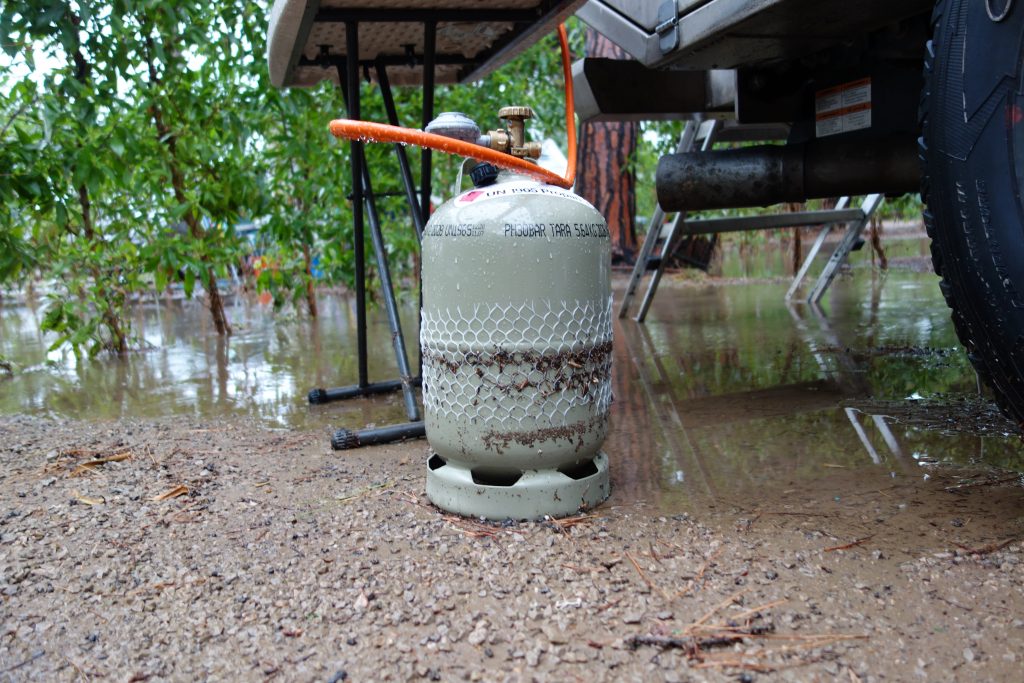
The morning we were leaving Barcelona we were hit with a mega storm and as it happens we were camped in a small depression. When the rain drained away its high water mark on our gas cylinder told the story.
Most visitors of central Europe don’t venture into southern Spain, presumably not because they don’t like olives. It’s just a little too far from the traditional tourist sites that are found around the continent’s great cities, rivers and mountains. But southern Spain, and particularly the autonomous region of Andalusia, rewards all who venture southward. We loved our time in Barcelona but as summer waned we wanted to head further south, stretch out our sunny days and take in what the rest of Spain had to offer.
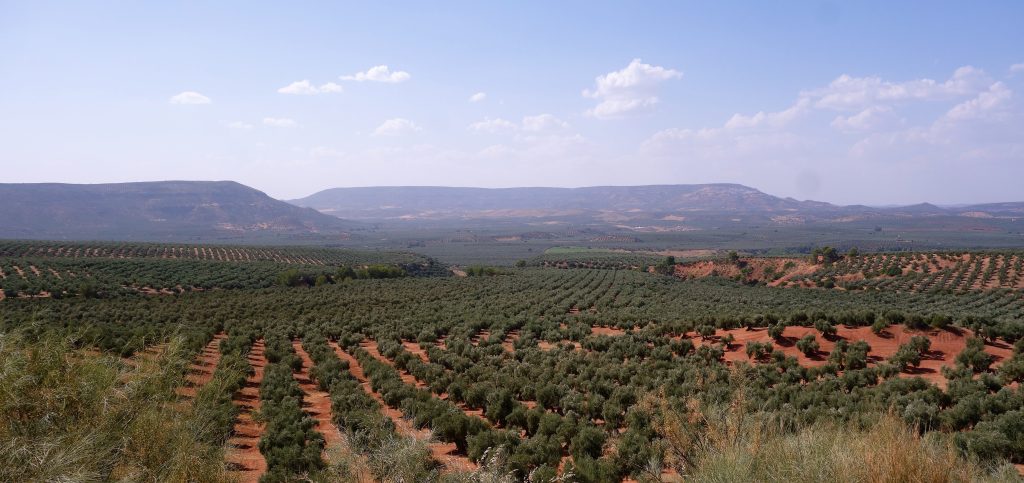
Olive trees would stretch as far as we could see – how the farmers harvest so many trees is beyond me
And what a surprise we had! Our first stop was Tarragona, Rome’s regional capital when they controlled the Iberian Peninsula, today sporting fabulous Roman ruins, the oldest Roman walls outside of Rome (200BC!), forums, aqueducts, an amphitheatre, a circus for their chariot races and much more. All this set on a beautiful coastline and an inviting little town built around the ruins.
Julie and I explored the narrow streets and walked along the ancient walls before visiting the amphitheatre outside the walls. The extension and sophistication of the Roman empire over 2,000 years ago never ceases to amaze us but to see all these well preserved ruins so far from Rome itself is truly amazing.
Give me a moment to complain about road tolls. For better or worse, road tolls are a part of life on the road and we’ve seen tolls of all levels on all types of roads. In some countries, such as Mexico and Colombia, you have no choice but to use the roads with huge tolls, in other countries like Ecuador the roads are fabulous and the tolls are laughably small. In Norway the toll amounts are unknown and they invoice you a month after you leave the country. In Italy and France the tolls can add up to 30 euros or more per day. No wonder we shun these roads whenever possible.
In Europe we are usually judged to be Class 1, a car, or sometimes Class 2, a van or small truck, and tolls vary accordingly. But in Spain we are judged by the electronic eye of each toll station as Class 3 which makes us a truck and the first few tolls were astronomically high. The stations are all electronic and there’s no one to argue with if you don’t agree. If we had continued on these toll roads we could have easily racked up charges of 100 euros per day. I don’t think so.
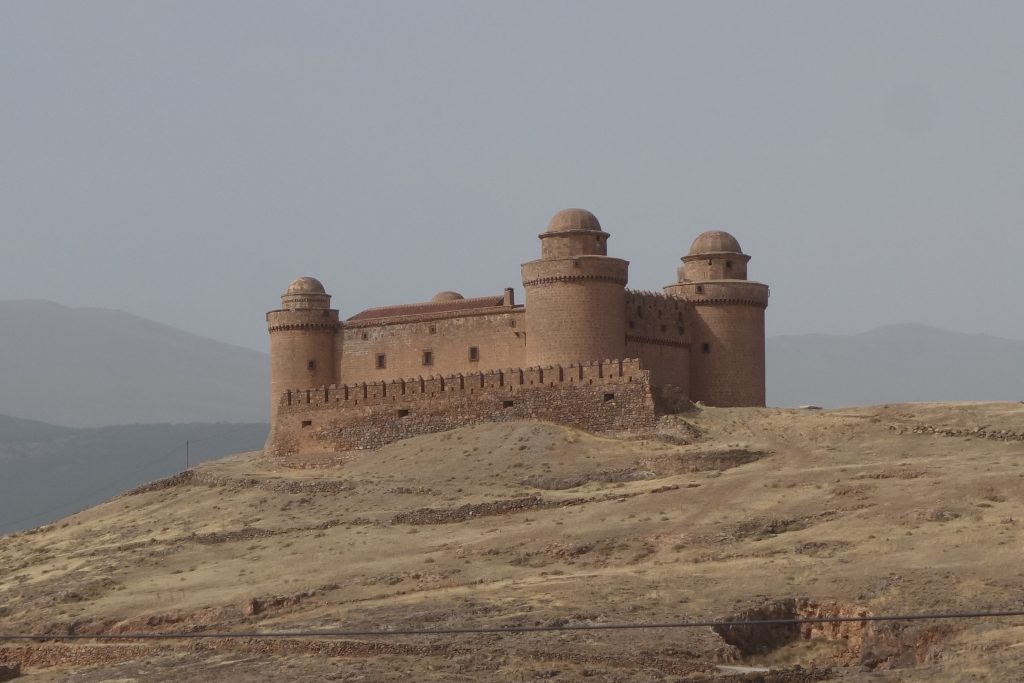
As fortune would have it, because we were avoiding road tolls we had a chance to come across scenes like this
So we asked our ever-obedient GPS Karen to exclude all toll roads. Following secondary roads, where the pace is slower and the views are better, we passed through endless olive groves and orange orchards until we made the beachside town with the amusing name of Peniscola. And what a place!
The best beaches we’ve seen on the Mediterranean by far, a small surf with crystal clear water and beautiful clean sand, still packed with people as the sun sank low, a medieval castle perched on the prominent point, a beautiful national park covering the coastline southward. Peniscola was our second huge surprise for the day, chock-a-block with sun-seeking tourists, a dramatic setting with all the goods. We had to camp there for the night, even if it was an overnight RV parking lot. Who cares, we’re in Peniscola.
The next day was all about olives. Having used up all our Peniscola jokes, our next target was the Andalusian city of Granada which hosts the world famous Alhambra. To get there we headed inland through the rolling hills and past picturesque towns perched on hillsides. Passing through the region of Valencia the olive groves had strong competition from the beautiful healthy orange orchards that covered the nearby slopes and sprouted the famous Valencia oranges.
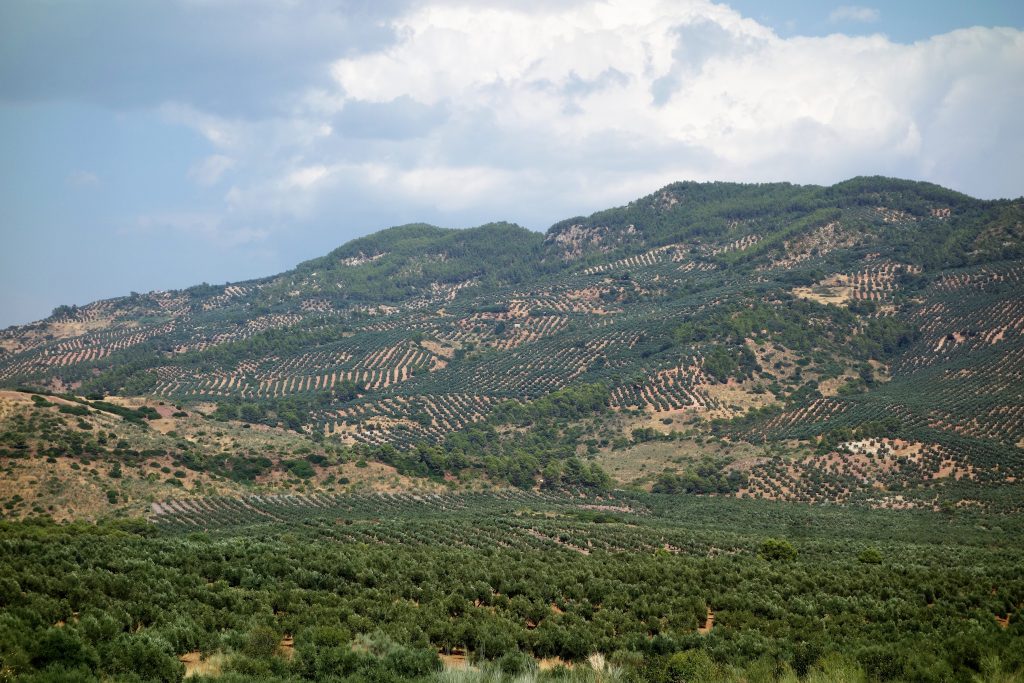
Yes, so then we came across some olive groves growing up and down the hills and they lasted for hours and hours…
But as we passed through Requena and up and over the mountains to the town of Albacete the oranges and occasional corn and hay gave way to olives. I mean, lots of olives. And as we drove south through Alcaraz and toward Ubeda we were literally, unequivocally and threateningly surrounded by olives. With the sun pounding down on us at 39C/102F olive groves ran up the mountain slopes, across the valleys, over the hills and across the river. Olive tress by the endless millions stretched as far as we could see in all directions, almost a little spooky. How can they harvest all these billions and billions of individual olives? The mind boggles.
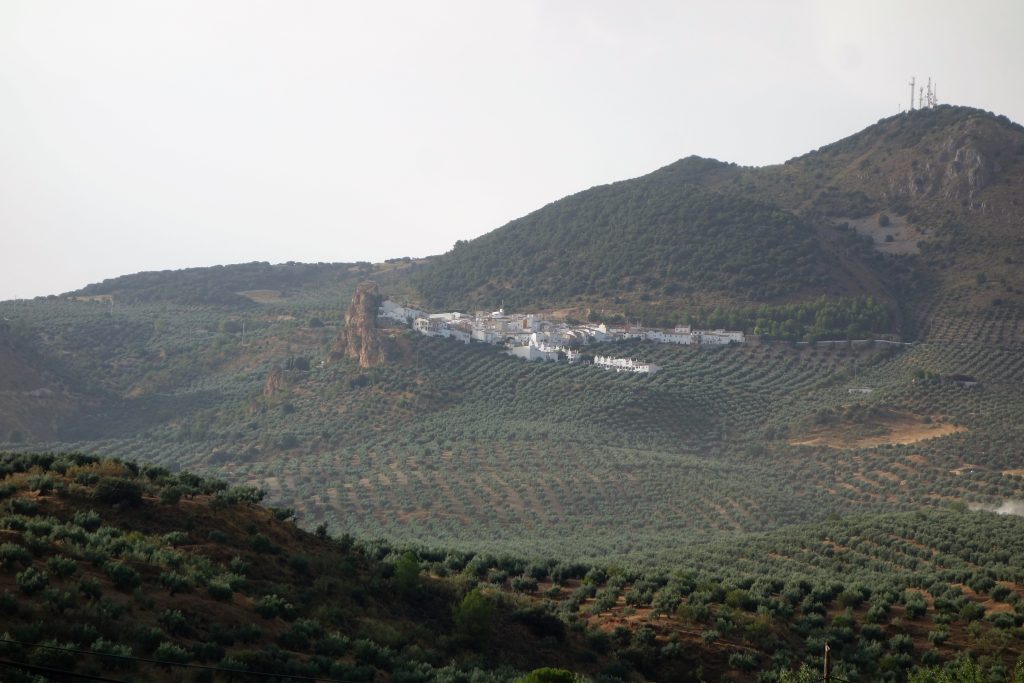
This small mountain village was somewhat lost in the morning glare but it is absolutely surrounded by olive trees
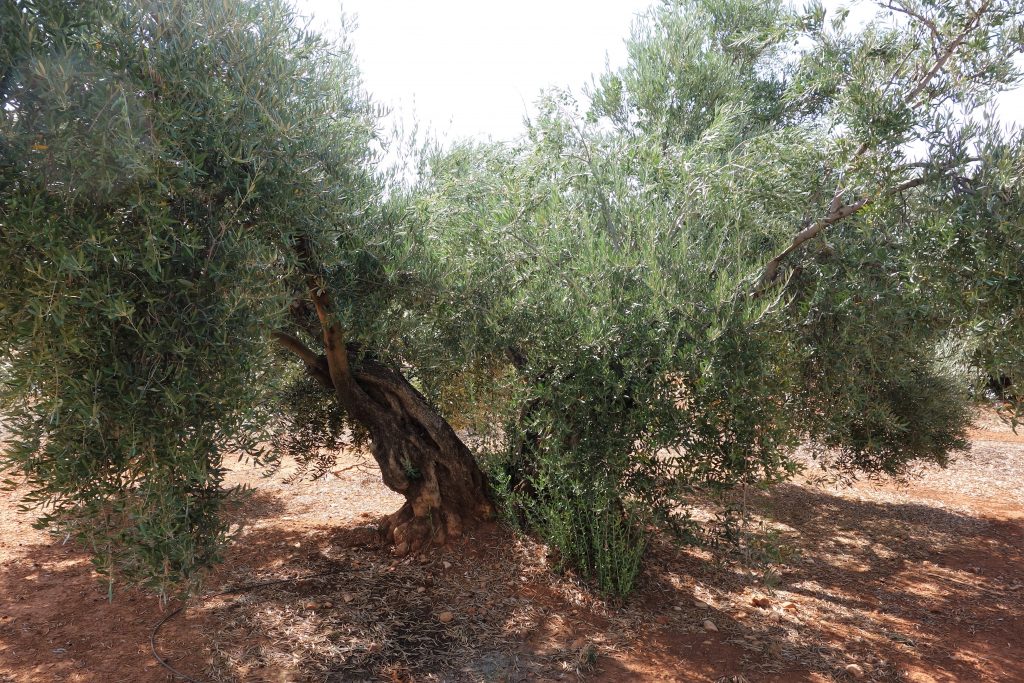
Olive trees are said to live hundreds, even thousands of years. This gnarly old thing had definitely seen a few sunsets.
We camped that night on a rare cleared field with olive trees stretching out before us like a hilly mirage in straight green rows. In suffocating heat Julie treated us to a beautiful cold meat and salad dinner, thankfully without olives.
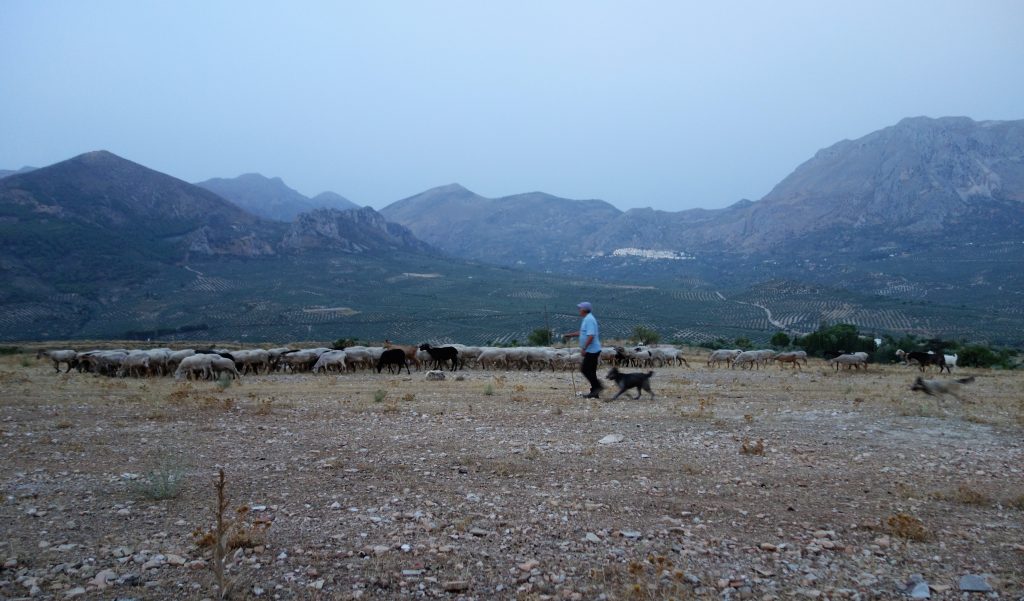
At dawn the next morning we were having our first coffee and enjoying the view of the olive trees on the other side of the valley when this shepherd and his two dogs came along with his herd of goats – talk about a timeless scene!
Between us and the Alhambra in Granada was a full day of mountains, scary narrow winding roads, white-washed villages and olives. The Sierra Nevada National Park protects a mountain range that separates the central plains of Spain with the southern coastline. South of the park is an area called Alpujarras and features a series of remote mountain villages where a curious episode of Spanish history took place.
In the 7th to 13th century the Moors, who were Muslims and dominated North Africa, expanded into the Iberian Peninsula and established a flourishing society based on their beliefs and featuring their architecture, food and cultural practices. That area, now called Andalusia, has a rich history and culture based on the Moorish influences. When they were forced out in the 13th century many Islamic devotees hid in these mountains and survived until well into the 15th century, almost hiding from society.
Today these small villages cling to the southern slopes of the Sierra Nevada mountains and for those willing to tackle the narrow, steep and winding roads, uncountable switchbacks and breathtaking views they are worth the challenge. Julie and I loved the drive, trying to imagine what it would have been like living in such a remote and harsh environment 700 years ago, and now enjoying how the villages were still surviving. Exploring the villages wasn’t easy and Tramp got stuck a couple of times down some very narrow roads but it was all for fun and we survived the experience.
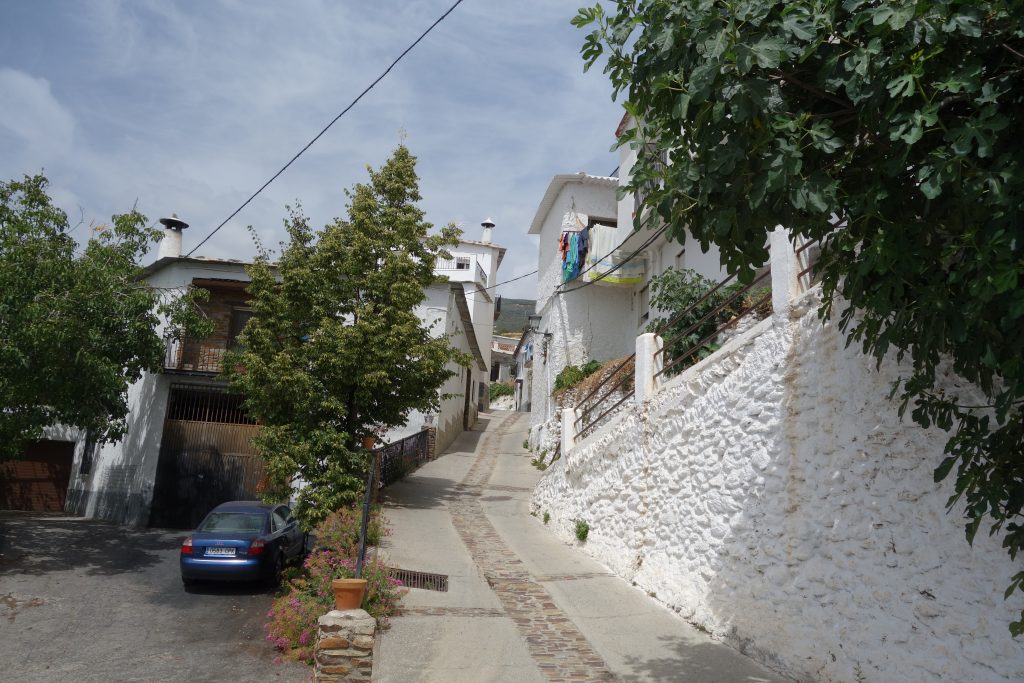
Don’t go up there Tramp! He got stuck a couple of times on the narrow roads but patient and sympathetic locals would always help us get out
Granada is in the heart of Andalusia and hosts one of the most outstanding examples of how the Moors influenced this land and what they left behind – La Alhambra. La Alhambra is an expansive palace and fortress built in the 13th to 15th century by a succession of Moorish kings and features beautiful Islamic architecture, elaborate gardens and ancient relics on display in the museum.
Julie and I spent the late afternoon exploring the various parts of the huge complex including the palace, gardens, Alcazaba (the military compound), Generalife (a recreational complex for the sultans) and associated buildings. Walking through the palace and the various buildings you could easily think you were in the Middle East or North Africa, admiring the beautiful mosaics, ceramics, roof carvings, paintings, decorative archways, gardens and fountains. It was a blistering hot day but Julie and I soaked it all in. Great stuff.

The King’s Palace, built after the Christians pushed out the Moors, was also part of La Alhambra’s complex (Julie is that small person giving the palace courtyard some scale)
Our time amongst the olives had ended after a night in a campground in the middle of…wait for it…an olive grove. From here we were heading towards Spain’s southern coastline. Can’t wait!
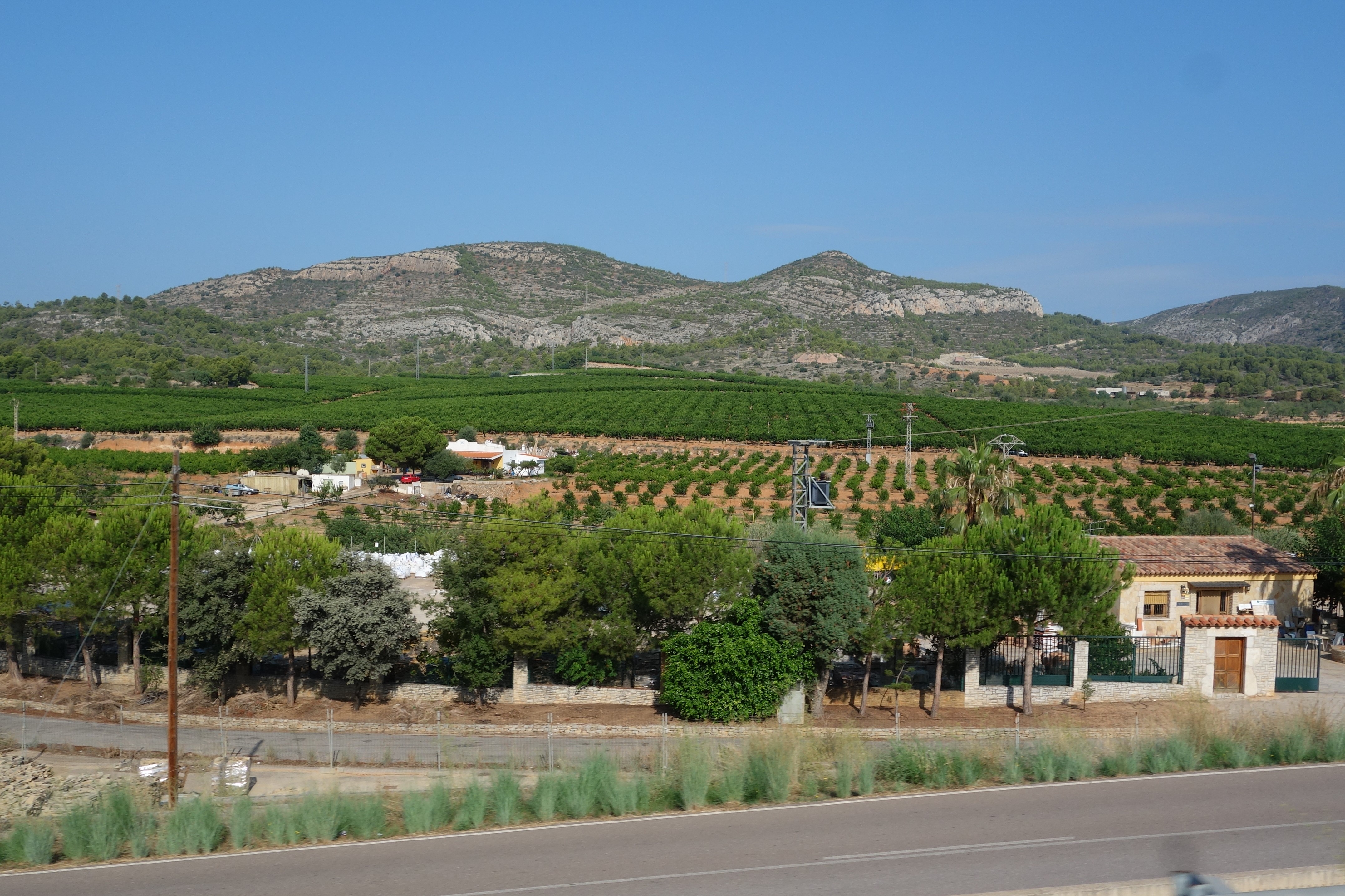



















Now that Kim & I have taken part in a Gisborne olive harvest (for 2 days) we may be qualified to assist in Spain……….
Hi Penny. You’d be experts by now! Brush up on your Espanol and get over to Andalusia as soon as possible. There’s alot of olives that need attention!
Bill